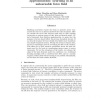Free Online Productivity Tools
i2Speak
i2Symbol
i2OCR
iTex2Img
iWeb2Print
iWeb2Shot
i2Type
iPdf2Split
iPdf2Merge
i2Bopomofo
i2Arabic
i2Style
i2Image
i2PDF
iLatex2Rtf
Sci2ools
NIPS
2001
2001
Linking Motor Learning to Function Approximation: Learning in an Unlearnable Force Field
Reaching movements require the brain to generate motor commands that rely on an internal model of the task's dynamics. Here we consider the errors that subjects make early in their reaching trajectories to various targets as they learn an internal model. Using a framework from function approximation, we argue that the sequence of errors should reflect the process of gradient descent. If so, then the sequence of errors should obey hidden state transitions of a simple dynamical system. Fitting the system to human data, we find a surprisingly good fit accounting for 98% of the variance. This allows us to draw tentative conclusions about the basis elements used by the brain in transforming sensory space to motor commands. To test the robustness of the results, we estimate the shape of the basis elements under two conditions: in a traditional learning paradigm with a consistent force field, and in a random sequence of force fields where learning is not possible. Remarkably, we find th...
| Added | 31 Oct 2010 |
| Updated | 31 Oct 2010 |
| Type | Conference |
| Year | 2001 |
| Where | NIPS |
| Authors | O. Donchin, Reza Shadmehr |
Comments (0)

